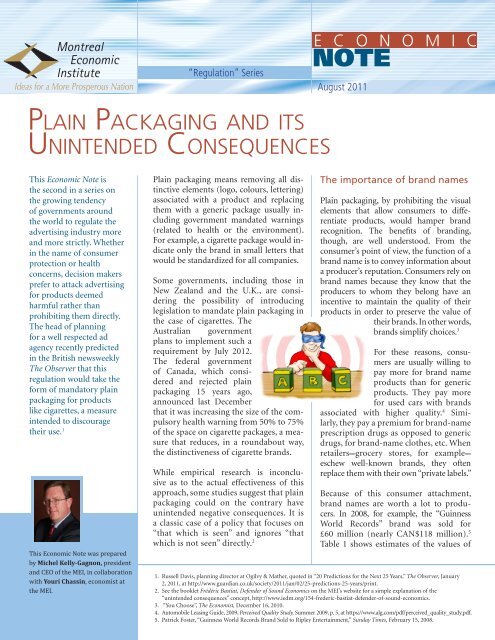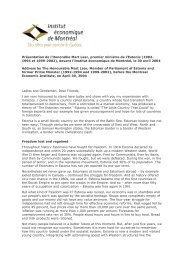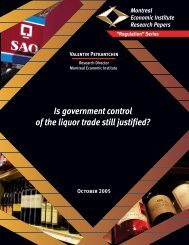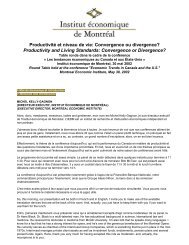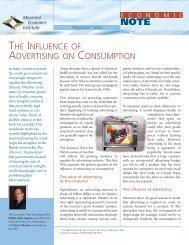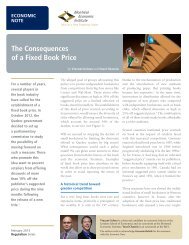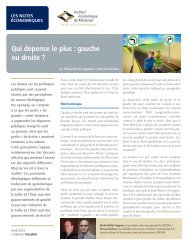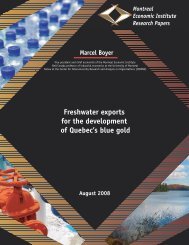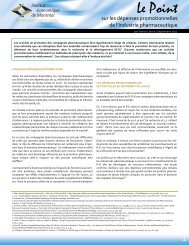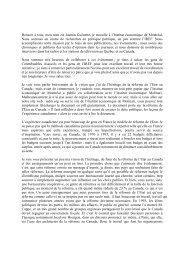Plain Packaging and its Unintended Consequences - IEDM
Plain Packaging and its Unintended Consequences - IEDM
Plain Packaging and its Unintended Consequences - IEDM
You also want an ePaper? Increase the reach of your titles
YUMPU automatically turns print PDFs into web optimized ePapers that Google loves.
This Economic Note was prepared<br />
by Michel Kelly-Gagnon, president<br />
<strong>and</strong> CEO of the MEI, in collaboration<br />
with Youri Chassin, economist at<br />
the MEI.<br />
“Regulation” Series<br />
<strong>Plain</strong> <strong>Packaging</strong> <strong>and</strong> <strong>its</strong><br />
<strong>Unintended</strong> conseqUences<br />
This Economic Note is<br />
the second in a series on<br />
the growing tendency<br />
of governments around<br />
the world to regulate the<br />
advertising industry more<br />
<strong>and</strong> more strictly. Whether<br />
in the name of consumer<br />
protection or health<br />
concerns, decision makers<br />
prefer to attack advertising<br />
for products deemed<br />
harmful rather than<br />
prohibiting them directly.<br />
The head of planning<br />
for a well respected ad<br />
agency recently predicted<br />
in the British newsweekly<br />
The Observer that this<br />
regulation would take the<br />
form of m<strong>and</strong>atory plain<br />
packaging for products<br />
like cigarettes, a measure<br />
intended to discourage<br />
their use. 1<br />
<strong>Plain</strong> packaging means removing all distinctive<br />
elements (logo, colours, lettering)<br />
associated with a product <strong>and</strong> replacing<br />
them with a generic package usually including<br />
government m<strong>and</strong>ated warnings<br />
(related to health or the environment).<br />
For example, a cigarette package would indicate<br />
only the br<strong>and</strong> in small letters that<br />
would be st<strong>and</strong>ardized for all companies.<br />
Some governments, including those in<br />
New Zeal<strong>and</strong> <strong>and</strong> the U.K., are considering<br />
the possibility of introducing<br />
legislation to m<strong>and</strong>ate plain packaging in<br />
the case of cigarettes. The<br />
Australian government<br />
plans to implement such a<br />
requirement by July 2012.<br />
The federal government<br />
of Canada, which considered<br />
<strong>and</strong> rejected plain<br />
packaging 15 years ago,<br />
announced last December<br />
that it was increasing the size of the compulsory<br />
health warning from 50% to 75%<br />
of the space on cigarette packages, a measure<br />
that reduces, in a roundabout way,<br />
the distinctiveness of cigarette br<strong>and</strong>s.<br />
While empirical research is inconclusive<br />
as to the actual effectiveness of this<br />
approach, some studies suggest that plain<br />
packaging could on the contrary have<br />
unintended negative consequences. It is<br />
a classic case of a policy that focuses on<br />
“that which is seen” <strong>and</strong> ignores “that<br />
which is not seen” directly. 2<br />
E C O N O M I C<br />
NOTE<br />
August 2011<br />
The importance of br<strong>and</strong> names<br />
<strong>Plain</strong> packaging, by prohibiting the visual<br />
elements that allow consumers to differentiate<br />
products, would hamper br<strong>and</strong><br />
recognition. The benef<strong>its</strong> of br<strong>and</strong>ing,<br />
though, are well understood. From the<br />
consumer’s point of view, the function of a<br />
br<strong>and</strong> name is to convey information about<br />
a producer’s reputation. Consumers rely on<br />
br<strong>and</strong> names because they know that the<br />
producers to whom they belong have an<br />
incentive to maintain the quality of their<br />
products in order to preserve the value of<br />
their br<strong>and</strong>s. In other words,<br />
br<strong>and</strong>s simplify choices. 3<br />
For these reasons, consumers<br />
are usually willing to<br />
pay more for br<strong>and</strong> name<br />
products than for generic<br />
products. They pay more<br />
for used cars with br<strong>and</strong>s<br />
associated with higher quality. 4 Similarly,<br />
they pay a premium for br<strong>and</strong>name<br />
prescription drugs as opposed to generic<br />
drugs, for br<strong>and</strong>name clothes, etc. When<br />
retailers—grocery stores, for example—<br />
eschew wellknown br<strong>and</strong>s, they often<br />
replace them with their own“private labels.”<br />
Because of this consumer attachment,<br />
br<strong>and</strong> names are worth a lot to producers.<br />
In 2008, for example, the “Guinness<br />
World Records” br<strong>and</strong> was sold for<br />
£60 million (nearly CAN$118 million). 5<br />
Table 1 shows estimates of the values of<br />
1. Russell Davis, planning director at Ogilvy & Mather, quoted in “20 Predictions for the Next 25 Years,” The Observer, January<br />
2, 2011, at http://www.guardian.co.uk/society/2011/jan/02/25predictions25years/print.<br />
2. See the booklet Frédéric Bastiat, Defender of Sound Economics on the MEI’s website for a simple explanation of the<br />
“unintended consequences” concept, http://www.iedm.org/154fredericbastiatdefenderofsoundeconomics.<br />
3. “You Choose”, The Economist, December 16, 2010.<br />
4. Automobile Leasing Guide, 2009, Perceived Quality Study, Summer 2009, p. 5, at https://www.alg.com/pdf/perceived_quality_study.pdf.<br />
5. Patrick Foster, “Guinness World Records Br<strong>and</strong> Sold to Ripley Entertainment,” Sunday Times, February 15, 2008.
Montreal Ecomomic Institute<br />
2<br />
ECONOMIC NOTE<br />
the 10 most valuable global br<strong>and</strong>s, which reach upwards of<br />
$70 billion for CocaCola—<strong>and</strong> that’s just for the “name.”<br />
Will plain packaging reduce<br />
tobacco consumption?<br />
Efforts to promote plain packaging emphasize the goal of reducing<br />
tobacco consumption <strong>and</strong> youth smoking initiation rates.<br />
Since no country has yet imposed plain packaging for cigarettes,<br />
the scientific literature on this subject offers no definitive conclusions.<br />
Analyses of the impact of such a measure usually rely<br />
on interviews, focus groups <strong>and</strong> experiments on recognizing <strong>and</strong><br />
recalling cigarette br<strong>and</strong> names. A number of such studies have<br />
been carried out over the years. But a review of 13 major publichealth<br />
studies that had found a potentially effective impact of<br />
plain packaging on smoking (<strong>and</strong> especially on youth smoking)<br />
has exposed major flaws in those studies. 6 Their results are ambiguous<br />
at best, <strong>and</strong> moreover do not support their conclusions.<br />
First, the studies often limit themselves to showing that consumers<br />
have a positive evaluation of br<strong>and</strong>s, or that health warnings<br />
are more readily noticed on a generic<br />
package, without actually showing that such<br />
factors have a determining influence on<br />
tobacco consumption.<br />
Also, the studies in favour of generic packaging<br />
do not follow the recognized methods<br />
of statistical analysis, which are required<br />
to demonstrate a causal link in the social<br />
sciences. They do not consider other factors that have an<br />
impact on youth smoking decisions—cigarette prices, parent <strong>and</strong><br />
peerinfluence,access,etc.—<strong>and</strong>thatarepotentiallymoreimportant<br />
than packaging. Such factors could reduce or completely cancel<br />
out the alleged positive impact of plain packaging.<br />
Finally, many of the studies reviewed show spurious correlations.<br />
A classic example of this unfortunate methodological error is<br />
provided by the positive correlation between drownings at sea<br />
<strong>and</strong> ice cream sales. Even though the correlation is real, it would<br />
be absurd to deduce that ice cream causes drowning. Rather, the<br />
positive correlation arises because both variables are correlated<br />
with a third, hidden variable: warm summer weather. Similarly,<br />
an apparent correlation between cigarette br<strong>and</strong> recognition <strong>and</strong><br />
the consumption of br<strong>and</strong>ed cigarettes could very well depend<br />
on the action of a third causal variable like peer influence.<br />
To sum up, the direct consequence of these methodological<br />
shortcomings is that no causal relation has been established<br />
between plain packaging of cigarettes <strong>and</strong> tobacco consumption.<br />
In other words, there is no scientific basis for the promotion of<br />
plain packaging.<br />
Proponents of plain packaging have long realized that <strong>its</strong><br />
effects would be at best marginal, as illustrated by an expert panel<br />
study commissioned by Health Canada, 7 whose conclusions are<br />
ambivalent. Indeed, a large part of the “evidence” reported was<br />
based on the opinions of teenagers interviewed in a mall. Half<br />
of them thought that plain packaging would not reduce the number<br />
of teenagers who decide to start smoking cigarettes, <strong>and</strong> just<br />
5.6% thought it was the best way to stop youths from smoking.<br />
The study concludes that,“generic packaging will not have major<br />
effects,” but nonetheless states that “it will be another nail in the<br />
coffin of smoking.”<br />
The real impact of packaging<br />
on tobacco consumption<br />
More useful are indirect studies that use<br />
actual health warnings as a proxy for plain<br />
packaging. Indeed, if plain packaging is to<br />
have an impact, existing health warnings,<br />
which amount to partial plain packaging,<br />
should have had some impact too. On the<br />
contrary, however, studies show that these health warnings<br />
have had no impact.<br />
An econometric study of the Canadian case highlights the<br />
fact that one year after appearing on Canadian packs of<br />
cigarettes in 2001, aggressive, graphic health warnings had<br />
had no statistically significant effect on the proportion of<br />
smokers in the population, even in the 15—19 age group. 8<br />
Health warnings on tobacco products have long been much<br />
more visible in Canada than in the United States. These<br />
warnings have occupied 20% of the front of each package<br />
since 1989, <strong>and</strong> 50% since 2001, compared to around 5%<br />
in the United States, usually on the side of the package.<br />
6. Jorge Padilla <strong>and</strong> Nadine Watson, A Critical Review of the Literature on Generic <strong>Packaging</strong> for Cigarettes: A Report for PMI, LECG Consulting Belgium, January 4, 2010.<br />
7. Health Canada, Expert Panel Report, When Packages Can’t Speak: Possible Impacts of <strong>Plain</strong> <strong>and</strong> Generic <strong>Packaging</strong> on Tobacco Products, 1995, Appendix C.<br />
8. Nikolay Gospodinov <strong>and</strong> Ian J. Irvine, “Global Health Warnings on Tobacco <strong>Packaging</strong>: Evidence from the Canadian Experiment,” The B.E. Journal of Economic<br />
Analysis <strong>and</strong> Policy, Vol. 4 (2004), No. 1.<br />
<strong>Plain</strong> <strong>Packaging</strong> <strong>and</strong> <strong>its</strong> <strong>Unintended</strong> conseqUences<br />
No causal relation has been<br />
established between plain<br />
packaging of cigarettes <strong>and</strong> tobacco<br />
consumption. In other words,<br />
there is no scientific basis for the<br />
promotion of plain packaging.
Logically, smoking rates should be lower in Canada since<br />
these warnings became more visible, if we adjust for other<br />
factors related to demographics, price <strong>and</strong> other variables.<br />
This is not, however, what is observed. Smoking rates in<br />
the United States, for young <strong>and</strong> old alike, have not been<br />
higher than in Canada in the last two decades, despite the<br />
less visible health warnings. 9 These health warnings have<br />
therefore clearly not produced the kinds of results expected.<br />
The real consequences<br />
Cigarette packages have recently been attacked by prohibiting<br />
the display of tobacco at points of sales in Canada,<br />
Thail<strong>and</strong>, Icel<strong>and</strong> <strong>and</strong> Irel<strong>and</strong>. In the Ca<br />
nadian provinces, these prohibitions have<br />
led to the closure of hundreds of small<br />
convenience stores. 10 However, they have<br />
had no discernable impact on smoking<br />
rates. They have merely encouraged smokers<br />
to buy their cigarettes at the supermarket<br />
(convenience stores no longer being<br />
able to display their range of available products) <strong>and</strong><br />
especially to buy contrab<strong>and</strong> cigarettes. With the prohibition<br />
of advertising, including at points of sales, packaging<br />
Table 1 - The Ten Most Valuable Global Br<strong>and</strong>s in 2010<br />
Br<strong>and</strong> Sector Value (US$ billion)<br />
1 Beverages 70.5<br />
2 Business services 64.7<br />
3 Computer software 60.9<br />
4 Internet services 43.6<br />
5 Diversified 42.8<br />
6 Restaurants 33.6<br />
7 Electronics 32.0<br />
8 Electronics 29.5<br />
9 Media 28.7<br />
10 Electronics 26.9<br />
Source: Estimates by Interbr<strong>and</strong>, http://www.interbr<strong>and</strong>.com/en/bestglobalbr<strong>and</strong>s/bestglobalbr<strong>and</strong>s2008/bestglobalbr<strong>and</strong>s2010.aspx.<br />
Smoking rates in the<br />
United States have not been<br />
higher than in Canada in the<br />
last two decades, despite less<br />
visible health warnings.<br />
remains the main method of br<strong>and</strong>ing, if not the only one,<br />
still available to cigarette producers.<br />
As with the display ban, there is a strong chance that plain<br />
packaging for cigarettes would entail unintended negative<br />
consequences without achieving <strong>its</strong> declared objective of<br />
improving the health of the population. Indeed, if consumers<br />
cannot rely on a br<strong>and</strong> as a warranty of quality <strong>and</strong> reputation,<br />
they will not be willing to pay a premium for those products.<br />
Concretely, plain packaging would reduce the br<strong>and</strong> premium<br />
<strong>and</strong> therefore the price of br<strong>and</strong> cigarettes. The consumption<br />
of tobacco would not fall, but cigarette manufacturers that have<br />
invested in establishing their reputations would be harmed. 11<br />
The distinction between the goal of reducing<br />
smoking <strong>and</strong> that of needlessly harming<br />
legitimate corporations is important here<br />
because the latter is clearly no longer a<br />
public health issue. <strong>Plain</strong> packaging would<br />
harm manufacturers just as the display ban<br />
harmed convenience stores, all without<br />
improving anybody’s health.<br />
In fact, by abolishing the br<strong>and</strong> premium, we can predict<br />
that sales will increase, according to the law of dem<strong>and</strong>.<br />
9. Casey Mulligan, Comparing Health Warning Label Sizes <strong>and</strong> Smoking Prevalence Rates in the US <strong>and</strong> Canada, December 2010.<br />
10. Patrick Basham, Canada’s Ruinous Tobacco Display Ban: Economic <strong>and</strong> Public Health Lessons, Institute of Economic Affairs, July 2010, p. 11.<br />
11. See: Denis Campbell, “’<strong>Plain</strong> Packets’ Law to Strip Cigarettes of Their Glamour,” The Observer, September 21, 2008.<br />
<strong>Plain</strong> <strong>Packaging</strong> <strong>and</strong> <strong>its</strong> <strong>Unintended</strong> conseqUences<br />
3<br />
Montreal Ecomomic Institute
Montreal Ecomomic Institute<br />
ECONOMIC NOTE<br />
According to a simulation on br<strong>and</strong> value<br />
carried out in Australia, prices would fall by<br />
5% to 19%. 12 Using conservative estimates for<br />
the Canadian market, we can predict that the<br />
reduction of the price of cigarettes resulting<br />
from a plain packaging policy would lead to<br />
the addition of 135,000 extra smokers (there<br />
are currently 4.8 million), an increase of nearly<br />
3%. 13 Although estimates are approximate by<br />
nature, logic dictates that<br />
a decrease in the price of<br />
cigarettes caused by the<br />
disappearance of br<strong>and</strong>names<br />
could provoke an increase in<br />
tobacco consumption.<br />
Thus, unless plain packaging<br />
succeeded in compensating<br />
for this probable increase,<br />
which it likely would not according to the current<br />
scientific literature, the adoption of this measure<br />
would have the opposite effect of what is intended.<br />
Conclusion<br />
The existing scientific literature does not establish<br />
a causal link between plain packaging <strong>and</strong><br />
tobacco consumption. In the absence of proof,<br />
any implementation would at best represent<br />
merely a shot in the dark as far as public health<br />
is concerned, <strong>and</strong> unfortunately risks provoking<br />
consequences that are more negative than positive.<br />
What the available evidence does show is that<br />
enforcing plain packaging on tobacco products<br />
would have detrimental consequences on legal<br />
12. Jorge Padilla, The Impact of <strong>Plain</strong> <strong>Packaging</strong> in Australia: A Simulation Exercise, LECG, 2010, p. 8; Jorge Padilla, The Impact<br />
of <strong>Plain</strong> <strong>Packaging</strong> of cigarettes in UK: A Simulation Exercice, LECG, 2010.<br />
13. Calculations by the author based on: Jessica Reid <strong>and</strong> David Hammond, Tobacco Use in Canada: Patterns <strong>and</strong> Trends, Propel Centre for<br />
Population Health Impact, 2011, p. 15; Gospodinov <strong>and</strong> Irvine, op. cit., footnote 8, p. 12.<br />
4<br />
<strong>Plain</strong> <strong>Packaging</strong> <strong>and</strong> <strong>its</strong> <strong>Unintended</strong> conseqUences<br />
Using conservative estimates for the<br />
Canadian market, we can predict<br />
that the reduction of the price of<br />
cigarettes resulting from a plain<br />
packaging policy would lead to the<br />
addition of 135,000 extra smokers.<br />
producers <strong>and</strong> their br<strong>and</strong>s, without reducing<br />
the consumption of tobacco. On the<br />
contrary, instead of reducing health risks,<br />
this policy would achieve the exact opposite<br />
of <strong>its</strong> stated purpose by leading to an increase<br />
in the number of smokers. It would not be<br />
the first time that a seemingly wellintentioned<br />
policy produces harmful unintended<br />
consequences.<br />
Moreover, tobacco may<br />
be just the first victim in a<br />
global attack on br<strong>and</strong>ing.<br />
Other products deemed<br />
“sinful” may well be targeted<br />
in the future: fast<br />
food,alcohol,lotterytickets<br />
(although the two latter<br />
cases currently enjoy the<br />
sanction of the Quebec government), etc.<br />
In economics, the availability of information<br />
is important. However, once the risks of using<br />
a product are known, to what extent does the<br />
government need to interfere with the choices<br />
of individuals in order to protect them from<br />
themselves? If everybody already knows that<br />
cigarettes cause health problems – <strong>and</strong> even<br />
impotence! – could we respect the choices of<br />
those who adopt this behaviour, even if this<br />
decision remains inscrutable to some?<br />
1010, Sherbrooke Street W., Suite 930<br />
Montreal (Quebec) H3A 2R7, Canada<br />
Telephone (514) 273-0969<br />
Fax (514) 273-2581<br />
Web site www.iedm.org<br />
The Montreal Economic Institute is an<br />
independent, non-partisan, not-for-profit<br />
research <strong>and</strong> educational organization.<br />
Through <strong>its</strong> publications, media<br />
appearances <strong>and</strong> conferences, the MEI<br />
stimulates debate on public policies in<br />
Quebec <strong>and</strong> across Canada by proposing<br />
wealth-creating reforms based on market<br />
mechanisms. It does not accept any<br />
government funding.<br />
The opinions expressed in this study do not<br />
necessarily represent those of the Montreal<br />
Economic Institute or of the members of <strong>its</strong><br />
board of directors.<br />
The publication of this study in no way<br />
implies that the Montreal Economic<br />
Institute or the members of <strong>its</strong> board of<br />
directors are in favour of or oppose the<br />
passage of any bill.<br />
Reproduction is authorized for<br />
non-commercial educational purposes<br />
provided the source is mentioned.<br />
Montreal Economic Institute<br />
© 2011<br />
Printed in Canada<br />
Illustration:<br />
Benoit Lafond<br />
Graphic Design:<br />
Mireille Dufour


